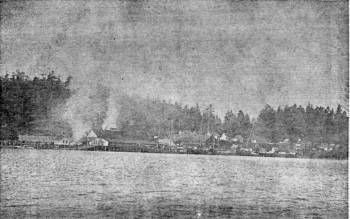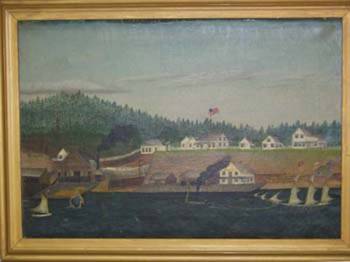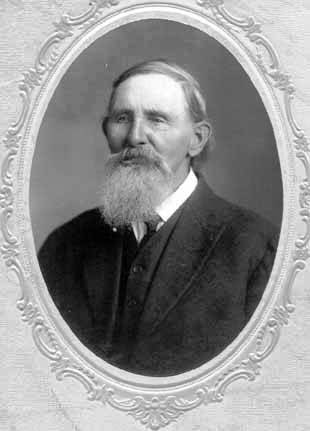
Peter Jepson
Peter's Ancestry
Once upon a time in Gothenberg, Skäne, which is the
province at the southern end of the country of Sweden, there lived a man
named Jöns. His name was pronounced "yuns" since in Swedish the "J"
has sort of a "ya" sound.. We can guess that he was born sometime about
1730-1750.
During his lifetime Frederick I was the king of Sweden. Voltaire estimated
the population of the country to be about three million, compared to 20
million in France and 10 million in England and Ireland. This was the Age of
Enlightenment. Benjamin Franklin was experimenting with electricity. The
great Swedish botanist, Lennaeus, a professor at the University at Uppsala,
was developing his system of plant nomenclature still used today. This was
also an age of superstition and belief in magic. Most peasants were sure
they heard elves and fairies in the woods. Reynolds and Gainsborough were
painting portraits of aristocrats. Bach and Handel were reaching the end of
their musical careers but Hayden and Mozart were just starting theirs. Both
Denmark and Sweden had passed laws requiring adherence to the Lutheran faith
and, being the state church, the government delegated to them the
responsibility of keeping records on the entire population. So, in their
annual visits to the members of their parish, the clergyman recorded all
births, marriages, deaths and moves from one residence or farm to another.
Sometime around 1770, just when there were rebellious stirrings here in the
colonies and the first calls for declaring independence from England, in
Gothenberg, Jöns became the proud father of a son, named Jeppa. As was the
practice in Sweden, being the son of Jöns, his full name was Jeppa Jönsson.
Jeppa went to Helsingborg, a seacoast city, where he earned his living
operating a ferryboat. In due time he married and on June 30, 1794, his son,
Andreas, was born. Andreas was, of course, called Andreas Jeppsson. There
probably were other children in this family also. We just haven’t found them
yet.
Andreas (Andrew) followed in his father’s footsteps. He operated a ferry
between Sweden and Denmark. He frequently ferried members of the royal
family from Helsingborg to Helsingor, Denmark.
At about the time Andrew Jackson was president of the United States, Andreas
Jeppsson found himself a bride in Helsingborg. Her name was Margareta
Rosendahl. She was 15 years younger than Andreas, the daughter of a
bricklayer, Eskel Rosendahl. Andreas and Margareta had seven children that we
know of, four sons - Carl, Jöns Petter, Edward, and Frank - and three
daughters - Beata, Christine, and Caroline. The sons kept their father’s
surname, Jeppsson, rather than using his first name to form Andersson or
Andreasson.
Carl was the eldest son. He left Sweden when he was 22 and went to
Melbourne, Australia to dig gold. He was never married and he never came
back to Sweden. He was 62 when he died. Beta was the eldest daughter. She
never married either. The second daughter, Christine, had two girls, Anna &
Betty, and one boy, John. The third sister, Caroline, had seven boys. One
died in infancy and two drowned when skating when they were rather small. A
fourth son died while he was still in high school. He was only 17. Her
husband died a year later in 1879. The other three sons, Nels, Andrew, and
Frank, all came to the United States as young men, but all returned to
Sweden later.
Jöns Petter Jeppsson aka Peter Jepson
Jöns Petter Jeppsson, Andreas’ second son, is the one we want to follow. He was born in Helsingborg on March 23, 1841. At age 14, at the time when pioneers were crossing the plains and mountains of this country in covered wagons on the Oregon and Mormon Trails, Jöns Petter (Peter) went to sea as a deck hand. These were the days of clipper ships with the huge sails before the advent of steam power. He sailed on Swedish ships first and then on foreign vessels. Each round trip would take several months and the crew was not usually paid until the end of the voyage. In 1860, sailing under a Belgian captain, he set out on a trip around South America and Cape Horn. Their goal was San Francisco, a thriving city of about 35,000 inhabitants. Apparently the captain was a harsh taskmaster because rather than remain with the ship for the return journey, Peter and some other members of the crew stayed in California. Being penniless, Peter found a job with a butcher in San Francisco who supplied the hotels with all kinds of meat. But he was not paid for his work. All he got was his board and a shirt and overalls. He did, however, learn the butcher trade, a skill which he put to use years later when he was farming.
The Oregon Years
After spending about six months in San Francisco,
Peter went north to North Bend, on Coos Bay in Oregon territory, where he
found work in a sawmill. Being inland people we think of walking or riding
horseback in those days to get from one place to another. But Peter was a
seaman. He probably sailed up the coast from San Francisco to North Bend on
one of the company ships which was making the return trip after bringing a
load of lumber down to San Francisco.
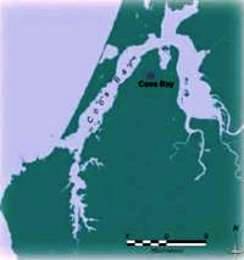
North Bend was a company town, founded and owned by Asa Simpson, who had
established the sawmill and a shipyard here. With a seemingly inexhaustible
supply of lumber on the steep hillsides which come right down to the
seacoast, he had established several such sites along the Oregon-Washington
coast and brought his products to San Francisco. Coos Bay was especially
well suited for development of a lumbering business because several fingers
of slough reached back into the hills from the bay providing natural
waterways for floating the logs down to the coast after they were rolled off
the hillsides.
|
North Bend in 1876 An illustration in Pioneer History of Coos and Curry Counties, Heroic Deeds and Thrilling Adventures of the Early Settlers published in 1898 in Oregon. |
Peter Jepson did this painting of that same shoreline as he remembered it.
|
Peter spent several years working in North Bend but eventually he became homesick for his native land. So in 1868 he returned to Sweden. Back home, Peter met his future bride, Margareta Lovisa Nyman, in the vicinity of Sofiero, the summer residence of the king of Sweden near Helsingborg. They were married on March 7, 1870. Now Peter’s longing was for Coos Bay so he brought his bride to this country.
According to Peter’s daughter, Emma, the
trip back to Oregon took six months. The route included sailing down around
South America and Cape Horn. Perhaps six weeks would be more accurate.
Peter and Lovisa are listed in the 1870 federal census for Coos County,
Oregon at Empire City. The census was taken on June 14, 1870.
Empire City was the first settlement at the mouth of Coos Bay. North
Bend was the next town in the bay and has always been identified as Peter's
home in family stories. Maybe he moved from Empire City to North Bend
after that census was taken or maybe North Bend was named because it was
bigger.
On this 1870 return trip to the West Coast Peter and his new wife were
accompanied by Peter’s two younger brothers, Edward and Frank. When they
reached North Bend the two brothers took up residence next door to the
newlyweds. By this time Peter was 29, four years older than Lovisa (Louise).
In January, 1871, Peter and Lovisa
became the parents of a daughter, Margareta Therese, and in January the following year a son was born. He was named
Andreas (Andrew) Leonard. John Ludvig came along in December, 1873, and
Frans Edvard (Frank Edward) was born in June, 1875. In 1876, learning that
Lovisa’s mother was ill, Peter and Lovisa, packed up the four children and
left North Bend and Coos Bay for good, arriving in Sweden by midsummer.
Eventually, as an adult, John moved back to this area but more about that
later.
On to Nebraska
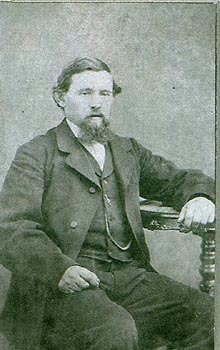
This time Peter determined to settle for good in his homeland and become a
farmer. In September, 1876, Emma Lovisa (Emma Louise) was born. Then Lovisa
became ill with cancer and died in February, 1880.
On April 5, 1881, Peter set out for the third time for this land which was
the birthplace of his first four children. He took these four children with
him but left Emma, who was only 3 1/2, with his youngest sister, Caroline.
This time Peter decided he would go to a place where he would not be tempted
by the seas so he brought his family to the middle of the continent. First
he found a job with the Burlington Railroad at Glenwood and Pacific
Junction, Iowa, near Council Bluffs. On September 19, 1881, he married Carlotta
Johanna Johannesdotter, also from Sweden, in Omaha Nebraska. They were
married by the pastor of a Sweddish Lutheran church.
Carlotta "Lotta" was 30 years old.
According to one family story, not
having married, Lotta was coming to this country to find a job as cook for
some wealthy family when she met Peter Jepson and his children on the ship
coming from Sweden. One can imagine the immediate connection that would have
been made when a single woman met a widower caring for four children under10
years of age all by himself.
Nebraska had become a state in 1867. Following the Civil War many
people came to settle here and claim land under the Homestead Act of 1862.
Under the terms of this act up to a quarter section of land, 160 acres,
could be acquired from the government by filing a claim at the nearest land
office and then living on the land for five years. In September, 1875, Gustaf A. Johnson acquired 80 acres of land through a Homestead Act land
patent 3 1/2 miles northwest of the Swedish community of Mead, Nebraska, in
Saunders County. By 1882 he and his wife had moved east to Douglas County
(Omaha) so he advertised this land for sale, probably in an Omaha paper.
Peter answered the ad and purchased the land in February, 1882, at
$15 per acre for $1,200. He took possession March 15, just in time to start
the new growing season. Later he bought an adjoining 100 acres for $27 per
acre.
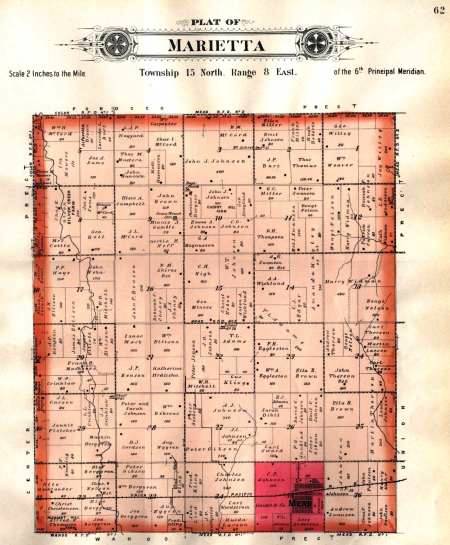
Marietta Precinct, Saunders County 1907 Atlas
Peter Jepson's property was on the west side of Section 22 northwest of Mead
Now, with his family finally settled in a permanent home, new members were added. In June, 1883, a son, Gustav Albert, was born; and a year later Alice Cornelia made her appearance. Peter decided it was time to bring home the one missing member of his family so he sent a message back to Sweden for his daughter, Emma, who was now 14, to come join him. She left Sweden on July 25, 1891, maybe by herself, or maybe with her cousins, the three sons of her Aunt Caroline.
On October 16, 1891, Peter Jepson’s family was completed when Edith Charlotte was born. Today we would refer to her as the tag-along child. Her half-siblings were 15-20 years older then her. Even her own full brother and sister were 8 and 7 when she was born. By this time, the oldest daughter, Therese, was off on her own starting her own family. Alice, at age 7, was too young to be of much help so the “mother’s assistant” job fell to Emma. Apparently Emma did not get along very well with her stepmother. She soon went to Illinois where her cousins were living.
The Later Years
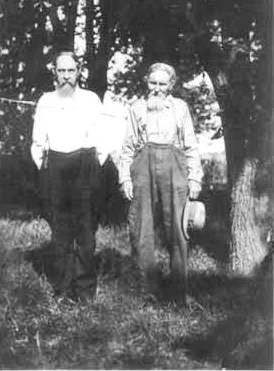
Peter Jepson (right) and a friend
Peter Jepson was now reaching the age when he could turn farming chores over
to his sons and take life a little easier. Three of them had gone to North
Dakota but his youngest son, Albert, still remained at home. Peter was a man
of varied talents. He could speak some German and Dutch as well as English
and, of course, his native Swedish. He believed everyone should be able to
speak at least two languages. He never forgot his days as a sailor. He did
pen and ink sketches of ships and coastal scenes. He also did some oil painting.
One of his paintings shows the farm at Mead with the white house on the
hill, the barn, a pond in the foreground. That painting now hangs in the
home of a great granddaughter.
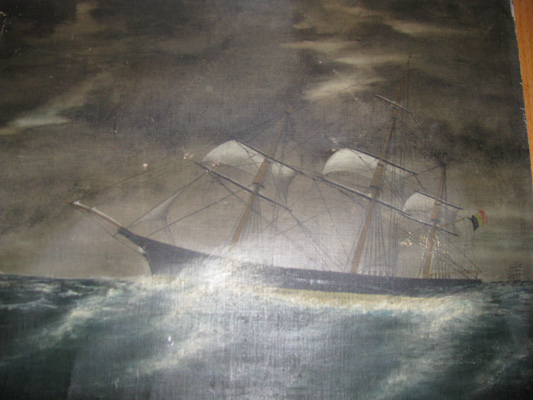
This painting of the full-rigged sailing ship is now in the possession of Peter's
great, great grandson, who provided this photo of the painting.
He painted a picture of a full-rigged sailing vessel under full sail and another one of a shipwrecked sailor clinging to a rent sail while in the distance one can see the barren rocky peaks of Cape Horn. Peter also built in great detail a miniature model of a full-rigged sailing ship. This ship was exhibited at the Trans-Mississippi Exposition in Omaha in 1898. It stood in the home of a great grandson until early in 2009. Then he donated it to the Durham Museum in Omaha where it is a part of the Trans-Mississippi Exposition Exhibit.
In 1908 Peter and Lotta purchased a home in Mead where they could live
in their retirement. The farm was rented to their farm hand, Emil Wilson, and
Albert joined his brothers in western North Dakota. Ten years later the farm
was sold to Emil, who had married Peter’s youngest child, Edith five
years before.
Peter Jepson died on May 27, 1924. According to his will, all of his
personal property and household furnishings were to go to his wife,
Charlotta, and at her death they would go to Edith. The exception was the
model of the sailing ship which was to go to Therese. The rest of the estate
was to go to Charlotta until her death and then be divided evenly with one
sixth to each of his five living children and the remaining sixth to Alice’s
children. Since Charlotta preceded her husband in death by about 2 1/2
weeks, the estate was settled immediately. Both Charlotta and Peter were
laid to rest in the Alma Lutheran Cemetery near Mead.
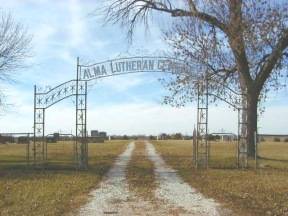
Alma Lutheran Cemetery southwest of Mead, Nebraska
Sources
Grave markers in Alma Lutheran Cemetery, Mead, Nebraska
Golden Valley County, ND, County Birth Records, (1912-1913).
Golden Valley News, “Jepson Rites Held at Wahoo, Neb”, Beach, ND, May 2,
1963, p 1.
Golden Valley News, “Pioneer Resident Succombs Friday”, Beach, ND, April 18,
1963, p 1.
Jepson, Dennis, photo of ship painting, copies of news articles about death of Pierce Jepson
Jepson, Francis Gleddie Birth Announcement, July 8, 1911, photocopy in MRA
Genealogy Notebooks.
Jepson, Frans E., Photo of Tombstone,
Alma Lutheran Cemetery, Mead, NE, by Mardi Anderson,
October, 1987.
Jepson, Peter - time line, 1988, by Aunt Maude L. Anderson
Jepson, Peter, "Old Swedish Tillers of the Soil", Swedish Agricultural
Magazine (1 Apr 1908).
Marriage License Record, Douglas County, Nebraska, Peter Jepson and Charlotte Johansen, September 18, 1881
Pursell,
Ethan & Jeannette, "Peter Jepson Family Group Sheets". Compiled Dec 30,
1994, 304 N. W. 41st St,
Oklahoma City, OK 73118.
Pursell, Jeannette, "Jonsson, Jepp & Jeppsson Family Group Sheets", compiled Dec 30 1994, 304 N. W. 41st St, Oklahoma City, OK 73118.
Social Security Death Index, Master File, (ancestry.com: Ancestry, Inc.,
2000).
Wilson, Edith, "Grandma's Scrapbook of clippings & funeral programs",
1965-1972, included with MRA's
Geneology Notebooks.
Wilson, Gilbert, Copies of Photos, annotated, December, 2002.
Wilson, Mildred, Certificate of Birth. Dept of Health & Human Services,
Lincoln, NE.
Wilson, Mildred, "Genealogy Adolphson, Karlsson, Wilhelmsson, Schold, Wilson"
(Lincoln, NE: self published, August, 1985).
